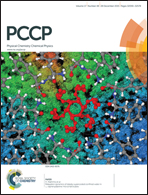Reaction between HN and SN: a possible channel for the interstellar formation of N2 and SH in the cold interstellar clouds†
Abstract
Using computational calculations the potential energy surface (PES) of the reaction between NH and NS has been analysed. The PES of the reaction shows the formation of two very stable species, HNSN and HNNS. Out of these two, HNNS which has the signature N–N linkage was found to be the most stable species in the PES. In view of the highly exothermic nature of the reaction surface, it has been proposed that these two species can possibly be detected in the interstellar space. For the first time it has also been shown that the reaction between the NH and NS can lead to the possible formation of N2via the isomer HNNS, and how the effect of tunnelling can make this reaction very much feasible, even under the extremely low temperature conditions prevailing in the interstellar medium. Based on the already reported results, a similar kind of behaviour for the NH + NO reaction surface has also been proposed. These dissociation reactions leading to the formation of N2 can be considered as potential secondary contributing channels while accounting for the total estimates of N2 in the interstellar medium, and thus HNNS as well as HNNO can be considered as stable reservoir molecules for interstellar N2. Besides the formation of N2, the formation of another astronomically important radical, SH in the cold interstellar clouds, has also been proposed.


 Please wait while we load your content...
Please wait while we load your content...